
Fuji Mountain
Share
Mount Fuji (富士山, Fujisan) is a mountain in central Japan that lies on the southern coast of the island of Honshū, southwest of the Tokyo metropolitan area. At 3,776 meters above sea level, it is the highest point in Japan. Located in a region where the Pacific, Eurasian and Philippine tectonic plates meet, the mountain is a stratovolcano still considered active, its last definite eruption having occurred in late 1707, although the eruptive risk is currently considered low.
At its summit has been built a meteorological observatory and despite the harsh climatic conditions, the mountain is an extremely popular destination especially for the Japanese, both Shinto and Buddhist, because of its characteristic shape and the traditional religious symbolism it represents. It has thus been the main subject or the setting of many artistic works, especially pictorial ones over the centuries. Yet, this frequentation weakens the environment. Therefore, on June 22, 2013, it was listed as a UNESCO World Heritage Site under the title "Fujisan, a sacred place and source of artistic inspiration".
Fuji Mountain Toponymy and etymology
Due to the existence of different transcription methods of Japanese, Mount Fuji has different names, some of which are wrong. For example, in Japanese, Mount Fuji is pronounced Fujisan, but due to a misreading of the kanji 山, Westerners sometimes call it "Fujiyama ".
To speak of "Mount Fujiyama" is in any case a mistake, as yama already means "mountain". It is also wrong to say that san is here the honorific suffix さん, aiming to personify Mount Fuji; san here does mean "mountain, mount".
Among the more than thirty other Japanese names for Mount Fuji that have become obsolete or poetic are Fuji-no-Yama (ふじの山 lit. Fuji Mountain), Fuji-no-Takane (ふじの高嶺, lit. the high peak of Fuji), Fuyō-hō (芙蓉峰, lit. Lotus Peak) and Fugaku (富岳 or 富嶽, lit. Fuji Mountain).
The kanji for Mount Fuji, 富 and 士, mean "wealth" or "abundance" and "a man with a certain status," respectively, but these characters are probably an ateji, that is, they were probably selected because of the similarity of their pronunciation to the syllables of the name but without possessing any particular meaning.
In the Nippon-shiki and Kunrei romanization methods, the name is transcribed Huzi. At the 1939 World's Fair in San Francisco, a giant photograph was titled "Mount Huzi". Nevertheless, the transcription Fuji, according to the Hepburn method, remains the most common in the world.
The origin of the name Fuji remains uncertain. One recent popular etymology claims that it comes from 不二 , meaning "without equal". Another states that it comes from 不尽 , meaning "without end".
A Japanese classical teacher of the Edo period, Hirata Atsutane, explains that the name is derived from a word meaning "a mountain rising with the shape of the ear of a rice plant". A British missionary, John Batchelor (1854-1944) hypothesizes that the name is derived from the Ainu word for "fire" (fuchi) of the goddess Kamui Fuchi, but he is contradicted by Japanese linguist Kyōsuke Kindaichi (1882-1971) on the basis of phonetic developments.
Also, huchi means "old woman" and ape "fire", ape huci kamuy being the goddess of fire. Research on the distribution of place names including fuji suggests that the origin of the name is yamato rather than aïnu.
Finally, a Japanese toponymist, Kanji Kagami, explains that the name has the same root as "wisteria" (fuji) and "rainbow" (variant of niji) and comes from its "long, well-formed slopes ". A text in the Taketori monogatari says that the name comes from "immortal" 不死 (fushi) and the image of abundant 富 (fu) soldiers 士 (shi) climbing the mountain slopes.
In reference to Mount Fuji, between 300 and 400 mountains in Japan are nicknamed "Fuji". These include Mount Rishiri (called "Rishiri Fuji"), Mount Yōtei ("Ezo Fuji"), Mount Iwaki ("Tsugaru Fuji"), Mount Iwate ("Nanbu Fuji" or "Nanbu Kata Fuji"), Mount Chōkai ("Dewa Fuji") Mount Bandai ("Aizu Fuji"), Mount Haruna ("Haruna Fuji"), Mount Nantai ("Nikkō Fuji"), Mount Mikami ("Ōmi Fuji"), Mount Daisen ("Hōki Fuji" or "Izumo Fuji"), or Mount Kaimon ("Satsuma Fuji").
Fuji Mountain Geography
Location
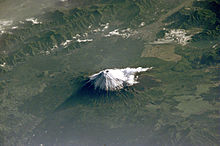
Mount Fuji is located in central Japan and the main island of Honshū, framed by the Akaishi Mountains of the Japanese Alps to the west, the Okuchichibu Mountains to the north and the Pacific Ocean to the south and east.
Administratively, it straddles the prefectures of Shizuoka in the south and Yamanashi in the north. Rising to 3,776 meters above sea level at the peak called Shin-Fuji, it is the highest point in Japan10, visible on clear days from Tokyo located less than 100 kilometers to the northeast.
It is bordered to the north by the five Fujigoko lakes: lake Motosu, lake Shōji, lake Sai, lake Kawaguchi and lake Yamanaka. It is possible to see the volcano from these lakes and from Lake Ashi.
At its feet lies the Aokigahara forest as well as cities such as Gotenba in the east, Fujiyoshida in the north and Fujinomiya in the southwest connected with the rest of the Japanese megalopolis, including the Tokyo metropolitan area which is located in the northeast, by a dense communication network consisting of roads, a freeway and a section of the Shinkansen high-speed train network.
Topography

The topography of Mount Fuji is dictated by the volcanism from which it was born: in the shape of a quasi-symmetrical cone of thirty kilometers at its base, its pronounced and regular slopes rise to 3,776 meters in altitude, conferring a volume of 870 km to this stratovolcano.
It is crowned by a crater of 500 to 700 meters in diameter for a depth of between 100 and 250 meters. The only real irregularity of its slopes is constituted by the Hōei-zan crater located at approximately 2,300 meters in altitude.
Geology
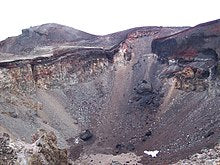
Mount Fuji is a stratovolcano which is part of the Pacific Ring of Fire and whose predominantly explosive eruptions classify it as a grey volcano10. The volcano is located at the triple junction between the Philippine plate and the Amur and Okhotsk micro-plates of the Eurasian plate.
These plates form the western and eastern parts of Japan and the Izu Peninsula, respectively. Mount Fuji is the northernmost volcano in the volcanic arc formed by the Izu Archipelago. In addition to the main summit crowned by a summit crater, the flanks and feet of Mount Fuji contain about 50 domes, cones and small eruptive vents.
Scientists have identified four distinct phases of volcanic activity in the formation of Mount Fuji. The first phase, called Sen-komitake, is composed of an andesite core recently discovered deep beneath the mountain.
The second, Komitake-Fuji, consists of a basalt layer probably formed several hundred thousand years ago. About 100,000 years ago, the "Old Fuji" would have formed on top of Komitake-Fuji. Finally, the "New Fuji" would have formed in place of the top of the "Old Fuji" about 10,000 years ago.
Mount Fuji is currently classified as active with a low eruptive risk. The last recorded eruption started on December 16, 1707 and ended around February 24, 1708, during the Edo period. It is sometimes referred to as the "great Hōei eruption".
During this event, a new volcanic crater, as well as a second peak, called Hōei-zan, formed at mid-slope on the southeastern side of the mountain10. Scientists predict minor volcanic activity in the next few years.
Climate and vegetation
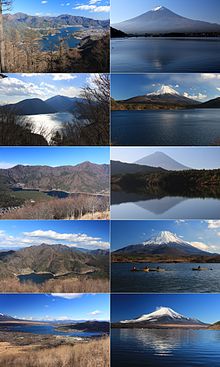
Because of the high altitude of the top of Mount Fuji, several climates are spread along its slopes. A large part of the mountain is beyond the alpine stage where a very cold and windy mountain climate prevails because of the altitude which limits the maintenance of the vegetation which has still not succeeded in regenerating itself completely since the last eruption occurred three centuries ago.
This harsh climate does not allow the snow that fell during the winter to melt significantly, which continues until May, with snowdrifts sometimes remaining all year round. The lower slopes are covered with forests and the feet of the mountain, enjoying a more temperate climate, are cultivated.
The average annual temperature is -6.5°C and average monthly temperatures range from -18°C to +8°C in August. Record temperatures are +18.2°C on August 16, 2007 and -35.5°C. On September 25, 1966, the meteorological station also measured the record wind speed for Japan with 91 m/s or about 330 km/h during the passage of a typhoon.
The high altitude of Mount Fuji and its relative distance from the other mountains in Japan sometimes cause the appearance of atmospheric turbulence called Karman vortex alley in case of wind.
This is why, on March 5, 1966, the British Overseas Airways Corporation Boeing 707 flight 911, caught in this type of turbulence, broke up in mid-air and crashed near Mount Fuji, shortly after take-off from Tokyo-Haneda International Airport, leaving no survivors (113 passengers and eleven crew members were present in the aircraft).
History of Fuji Mountain
Eruptive history
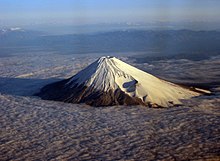
Following the "Old Fuji" phase, a 4,000-year period of inactivity occurred, ending 5,000 years ago with the current "New Fuji" phase. Mount Fuji's eruptions feature lava flows, magma, slag and volcanic ash emissions, collapses and sideways eruptions, hence the term "big eruption store".
The ash of New Fuji is often black and its eruptions are recent in terms of geological layers. Valuable information is recorded in Japanese historical documents from the seventh century. They present a series of representative eruptions.
Mount Fuji in prehistoric times
Four explosive eruptions occurred during the Jōmon period about 3,000 years ago, known as Sengoku (Sg), Ōsawa (Os), Ōmuro (Om) and Sunazawa (Zn). Since the wind usually blows from the west in the Mount Fuji area, most of the ejecta fell to the east, but in the case of Ōsawa, the slag and ash were carried by an east wind to the vicinity of Hamamatsu.
About 2,300 years ago, the eastern slope of the volcano collapsed and mudflows flowed down to the Gotenba area as far as the Ashigara Plain to the east and Suruga Bay through Mishima City to the south. This incident is now called the Gotenba lava flow (御殿場泥流, Gotemba deiryū).
The Jōgan eruption
In 864 (the sixth year of the Jōgan era), an eruption takes place on the northeast slope of Mount Fuji producing a large amount of lava. Lava fills the vast Senoumi Lake (せの海), dividing it in two and forming the present-day Sai Lake (西湖) and Shōji Lake (精進湖). This event is known as the Aokigahara lava (青木ヶ原溶岩) and the place is currently covered by the dense Aokigahara forest.
"Jōgan 6, the fifth month: Mount Fuji has been erupting for 10 days and it ejects a huge amount of clinker and ash from the summit that falls back to earth to the ocean at Edo Bay. Many people perished and a large number of houses were destroyed. The volcanic eruption started on the flank of Fuji-San, near Mount Asama, throwing ash as far as Kai Province."
- Siyun-sai Rin-siyo, Hayashi Gahō, Nihon Ōdai Ichiran
The eruption of Hōei
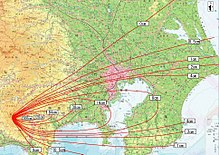
The last eruption of Mount Fuji, which occurred in 1707 (the fourth year of the Hōei era), is known as the "Great Hōei Eruption." Beginning 49 days after the Hōei earthquake, which is among the most powerful earthquakes ever recorded in Japan, it took place on the southwestern slope of Mount Fuji and formed three new volcanic vents, named "first," "second," and "third vent."
"Hōei 4, the twenty-second day of the tenth month: an eruption of Mount Fuji. Clinker and ash fall like rain in Izu, Kai, Sagami and Musashi."
- Siyun-sai Rin-siyo, Hayashi Gahō, Nihon Ōdai Ichiran
Although it did not generate a lava flow, this eruption is notable for the spread of volcanic ash and slag emitted to an area as far away as Edo (the former name of Tokyo) located one hundred kilometers to the northeast. The volume of ejecta was estimated to be 800,000,000 m3, a volcanic explosivity index that could be estimated at 4.
The following year, the volcanic debris accumulated in the fields near the course of the Sakawa River, located east of the mountain, was mobilized by the rains, filling the bed of the river and forming temporary dams here and there. The downpour of August 7 and 8 caused an avalanche of ash and mud that destroyed the dams, causing a flood in the Ashigara plain.
Other known eruptions
Sixteen eruptions have been recorded since 781. Most of them took place during the Heian period with twelve eruptions between 800 and 1083. Sometimes the periods of inactivity can last for hundreds of years as between 1083 and 1511. Currently, no eruptions have occurred since the Hōei eruption over 300 years ago.
Prevention
The prevention of eruptive risks is carried out by the Coordination Committee for the Prevention of Volcanic Eruptions under the Japan Meteorological Agency with regard to the prediction and seismic monitoring of events, the Prime Minister's Office with regard to the implementation of an evacuation plan, and the Ministry of Land, Infrastructure, and Transport for the protection against landslide risks.
Between September 2000 and January 2001, the number of earthquakes under the volcano increased from one or two per month to 35 in September, 133 in October, 222 in November, 144 in December and 36 in January 2001, raising fears of the worst, before everything returned to normal.
These tremors were mostly of the low-frequency type and were located fifteen kilometers deep, northeast of the summit.
In September 2012, the pressure of the magma chamber was 1.6 MPa, equivalent to an atmospheric pressure of 15.8 kg/cm2, raising fears of an eruption theoretically possible from a pressure of 0.1 MPa. This high pressure is due to tectonic movements caused by the 2011 Tōhoku Pacific Coast earthquake.
First ascent
The first known ascent of Mount Fuji is dated 663 and was made by the Buddhist monk En no Gyōja. The first non-Japanese to climb the volcano was Sir Rutherford Alcock in 1860.
Shintoism, like Buddhism, imposes prohibitions in relation to all things related to blood. Women, for example, because of menstruation, are considered impure. As a result, they are excluded from the holy places of both religions, especially from mountains such as Mount Fuji.The status of Mount Fuji in the culture is not the same as that of the other religions.
The status of Mount Fuji in Japanese culture, however, encouraged women to defy this prohibition; in 1832, Takayama Tatsu, a young woman member of a Mount Fuji worshipping sect, joined a group of pilgrims in men's clothing and, with the kindness of her spiritual master, made the first known ascent of the volcano by a woman. In the late Edo period, the first woman to climb Mount Fuji was a woman.
At the end of the Edo period, religious authorities, anxious to attract more believers to temples and shrines, began to consider lifting the ban on women climbing sacred mountains in order to encourage them to visit the holy places built at the foot of the mountains or on their slopes.
Thus, from the first year of the Man'en era (1860-1861), women were allowed to climb Mount Fuji up to the eighth station, at an altitude of about 3,200 meters. This movement of openness accelerated in the following years.
This movement of openness accelerated in the following years under the impulse of foreign personalities; in September 1867, the British diplomat Harry Smith Parkes climbed Mount Fuji with his wife, Fanny Parkes, who became the first non-Japanese woman to enter the sacred perimeter of the volcano.
The presence of a woman, and a foreigner at that, on the summit of Mount Fuji did not arouse any opposition or protest in the country, so Japanese women took the initiative to ask for permission to climb it as well. Five years later, the Meiji government lifted the ban nationwide by ordinance. Since then, Mount Fuji has been a popular tourist destination and many Japanese people have climbed it at least once in their lives.
Military presence
Samurai once practiced their training at the foot of Mount Fuji, near the present-day town of Gotenba. Shogun Minamoto no Yoritomo practiced yabusame in the area during the early Kamakura period. Since 2006, the Japanese Self-Defense Forces at Camp Kita-Fuji (northeast) and Higashi-Fuji (southeast), as well as the U.S. Marine Corps at Camp Fuji (Kantō Plain), have had military bases at the base of the volcano.
Activities in Fuji Mountain
Climbing
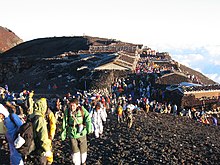
The ascent of Mount Fuji is relatively easy although it can be tiring because of the great horizontal distance to be covered between the starting point on foot and the summit. Sometimes its paths are crowded, the volcano being a popular pilgrimage place, except in winter when it is covered with snow and ice.
The busiest time to climb Mount Fuji is from July 1 to August 27 because of the summer opening of the huts and other tourist facilities and the bus traffic to the fifth station, the last one accessible by road and the closest to the summit. Every year, the number of visitors climbing Mount Fuji is about 300,000 people, 30% of whom are foreigners.
The ascent can take between three and eight hours and the descent between two and five hours. The hike is divided into ten stations and the route ends at the fifth station, at about 2,300 meters above sea level, whose huts are not often open at night for hikers.
There are four major routes to the summit from this fifth station: Kawaguchiko, Subashiri, Gotenba and Fujinomiya (clockwise) with four secondary routes from the foot of the mountain: Shojiko, Yoshida, Suyama and Murayama.
The stations along the different routes are located at various altitudes: the highest, the fifth station located at Fujinomiya, is followed by Kawaguchiko, Subashiri and Gotenba. Although it is only the second highest of the five stations, Kawaguchiko is the most popular because of its large parking area.
Although most hikers do not climb the Subashiri and Gotenba routes, many hikers use them on their way down to enjoy their volcanic ash-covered trails.
Thus, it is possible to cover the distance between the seventh and the fifth station in only thirty minutes. It is also possible to make the ascent with a mountain bike in order to enjoy the descent, although the exercise is particularly risky because of the crowd and the difficulty of controlling the speed.
The four routes from the foot of the mountain offer access to historical sites: Murayama is the oldest, while Yoshida has many ancient shrines, teahouses and refuges along the trail from which Asiatic black bears are sometimes visible. Every August 26, a torchlight retreat is held, passing through Shinto temples and going to Yoshida Shrine.
These routes, which have recently gained popularity, are therefore restored. At the summit, the path allows to reach each of the eight peaks located on the rim of the summit crater, the highest of which has the radar system.
The climbers who made the ascent at night, in addition to having avoided the trying hike under the sun, have the privilege to attend the sunrise from the summit, an event particularly appreciated by the Japanese, especially in the night of December 31 to January 1 and that in spite of the difficult climatic conditions. It is then possible to observe the panorama during the descent.
Until the end of May, Mount Fuji offers various ski touring routes on its northeast side, starting from the 5th station (2,300 m). The access road is open from 3:00 am.

Sport
Paragliders take off from the vicinity of the Gotenba parking lot, between Subashiri and Hōei-zan Peak, on the southern slope of the mountain, or sometimes from other locations depending on wind direction. Several paragliding schools use the volcano's extensive half-sand/half-grass slopes as training grounds.
In 1913, a first mountain race was organized from the station of Gotemba to the top of the volcano. The race was then extended to an "ascent and descent" format, but this new, particularly difficult format saw some competitors faint.
The race was then transformed into an ekiden relay in 1923, following a looped course on the side of the volcano. Suspended during the Second World War, the race was briefly re-launched in the early 1950s and then permanently since 197635.
The Mount Fuji Race was born in 1948. Starting from the ancient city of Fujikamiyoshida (now Fujiyoshida), it reaches the top of the volcano following the Yoshida route.
Since 2012, an ultra-trail called Mt.Fuji Ultra-Trail has been held every year in April at the foot of Mt.Fuji. The event becomes part of the Ultra-Trail World Tour as the fifth stage of a ten-race world circuit when it was founded in 2013.
There is also a car circuit at the foot of Mount Fuji: the Fuji Speedway. The 4.563 km track was established in 1965 and hosted the Formula One Japanese Grand Prix in 1976 and 1977. That year, a serious accident involving Gilles Villeneuve's Ferrari resulted in the death of a spectator and a track marshal.
Japan was deprived of a Grand Prix until 1987, when it was held at Suzuka until 2006. In 2000, the Mount Fuji circuit became the property of Toyota and finally, in 2007, the competition made a comeback there with the victory of Lewis Hamilton.
Environmental protection
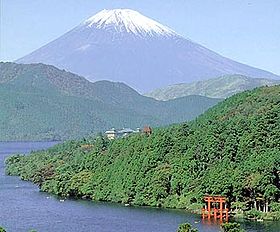
Mount Fuji is part of Fuji-Hakone-Izu National Park along with the five lakes of Fuji, Hakone, Izu Peninsula and Izu Archipelago . It is home to many species of wild birds, which is why it is called a "wild bird paradise " , and is known to be home to rare species of lizards, especially the Takydromus tachydromoides lizard.
A candidate since 200741 , Mount Fuji was inscribed on UNESCO's list of World Heritage cultural properties in June 2013. The project, which was born in the early 1990s, seemed impossible to achieve due to the drastic environmental conditions, but this prospect has pushed the authorities to launch a plan to clean up this emblematic mountain.
Observatory
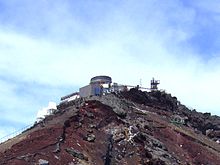
Mount Fuji weather station in 2007, without the radar. Its round base in the center is still visible.
In 1932, a temporary weather station was installed on the top of Mount Fuji. It collected a lot of information and sent it by VHF wave.
In 1936, it was decided to transform it into a permanent station, which made it the highest in the world at that time. One of the goals of the meteorological station is to obtain data at altitude in order to better feed the atmospheric models to predict typhoons by measuring the air temperature, humidity and atmospheric pressure.
On August 15, 1964, the installation was completed with the Mount Fuji weather radar with a range of 800 kilometers and a circular antenna of five meters in diameter. In spite of the difficult weather conditions, it was used at this location until the end of 1999 when its distant watch function was replaced by weather satellites.
The antenna, radome and supporting equipment were brought down in 2004 to the foot of the mountain, to the new Fujiyoshida Millimeter Observatory, where they are part of a museum.
Museums
On the shores of Lake Kawaguchi, one of the five lakes of Mount Fuji, the Kawaguchiko Art Museum allows to see a small collection of paintings and photographs directly related to Mount Fuji.
Industries
The groundwater of Mount Fuji and its surroundings is used for pharmaceutical purposes, for paper industries and as mineral water due to its richness in vanadium. There are famous hot springs all around the volcano which have enabled the development of spa tourism.
The name "Fuji" serves as a franchise for a number of companies in Japan, one of the best known being Fujifilm, the brand of photo film and manufacturer of digital cameras.
Fuji Mountain In popular culture
Artistic representations
Because of its unusually symmetrical mountain profile, Mount Fuji has become one of the symbols of Japan. After having inspired many poets, it appears in countless pictorial representations (emaki or illustrated scrolls, mandalas such as Fuji-sankei, ukiyoe prints or handicraft). The oldest found is a drawing on paper of a sliding door dating from around the tenth century .
It was the object of particular attachment by nineteenth-century Japanese painters who, like the Japanese print master Hokusai (1760-1849) with his Thirty-Six Views of Mount Fuji (Fugaku Sanjūrokkei, 1831), strongly influenced European impressionism. In 1835, the same Hokusai published his series of One Hundred Views of Mount Fuji (Fugaku Hyakkei) in the form of three books in black and gray.


At the same time, another great artist, Hiroshige (1797-1858), presented in 1833-1834 the Fifty-three Stations of the Tōkaidō, which he would decline in a dozen completely original editions until 1857. He also painted two personal series of Thirty-six Views of Mount Fuji.


In the same period, Utagawa Kuniyoshi (1798-1861) painted some representations of Mount Fuji.


More recently, Kobayashi Kokei (1883-1957) painted Fuji and Yokoyama Misao (1920-1973) painted the Red Fuji (Aka-Fuji). Shinya Shimoto, who mainly paints pictures related to natural disasters, devoted a whole series of paintings to Mount Fuji.
Religious symbolism
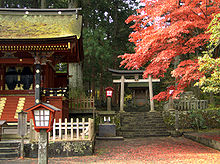
Mount Fuji has been a sacred mountain since the 6th century. Many Japanese synonyms for Mount Fuji also reflect its religious character. In Shintoism, the legend tells that an emperor ordered to destroy on the top of the mountain an elixir of immortality that he held: the smoke that sometimes escapes from the mountain would be due to this beverage that is consumed.
Moreover, according to tradition, the Shinto deities Fuji-hime and Sakuya-hime live there as well as Kono-banasakuya-hime, "The princess who makes trees blossom" (in particular cherry trees). Buddhism reveres its shape, which is reminiscent of the white bud and eight petals of the lotus flower.
All these reasons make that its ascent is forbidden to women until 1872: a chapel called Nyonin-do ("women's refuge") allows them to wait for their husbands, sons or brothers.
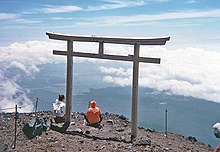
In order to worship the many deities of different religions, several shrines, such as the Fujisan Hongū Sengen-taisha and the Asama shrines, have been built on or at the foot of Mount Fuji and many torii line the route to mark the boundaries of the sacred precinct.
Brotherhoods (Fuji-kō) have been established there since the seventeenth century to venerate the mountain and hold pilgrimages to it, following the example of Hasegawa Takematsu in 1630. These groups then build small-scale replicas of Mount Fuji called fujizuka (富士塚) for their members who are unable to make the pilgrimage.
It was around the time of the death of Jikigyō Miroku (1671-1733), who died while fasting on Mount Fuji, that faith turned into religion and the climb became ritualistic, even if his thought was misinterpreted.
More recently, sects specifically dedicated to the worship of Mount Fuji have been established, mainly in the 1940s such as the Fuji-Gōho sect founded in 1946 by Ito Gensaku and the Fuji-Kyō sect founded in 1948 by Hasegawa Teruhiro.
Filmographic works
- Fuji no shirayuki, 1935, directed by Hiroshi Inagaki
- Fushi shan zhi lian, 1954, directed by Kangshi Mu
- Chiyari Fuji, 1955, directed by Tomu Uchida
- Kumonosu-jô (The Spider's Castle), 1957, directed by Akira Kurosawa (setting of the castle on the slopes of Mount Fuji)
- Nihon to nihonjin, 1970, directed by Kon Ichikawa
- Fuji, 1974, directed by Robert Breer
- Ki no umi, 2004, directed by Tomoyuki Takimoto
- Pacific Rim Uprising, 2018, directed by Steven S. DeKnight: Mount Fuji is the main target of the Kaijûs, who want to use it to trigger a terraformation that will eradicate humanity. A Kaijû can be seen climbing the volcano towards the end of the film.
Video games
- In the Mystical Ninja starring Goemon, the player must climb Mount Fuji to find a character who runs a store on top of it.
- In the Pokémon Gold, Silver, Crystal, HeartGold, and SoulSilver video games, the final confrontation pitting the player against Red takes place atop Mount Silver, a snowy mountain heavily inspired by Mount Fuji.
- In the video game Ōkami, the player must go to the mountains of Japan, the largest of which is named Ezofugi. This name is taken from Ezo, which is the name of the Ainu natives of Mount Yōtei in Hokkaido, and Fugi, the name of the largest mountain in Japan, located on the island of Honshū.
- In the racing game DriveClub, Mount Fuji appears on the various tracks located in Japan: Nakasendō, Lake Shōji, Asagiri Hills Racetrack, Takahagi Hills and Goshodaira.
- In racing games in general, Mount Fuji appears in the background on the Fuji Speedway track.
- In the game Inazuma Eleven 2, the player accesses Mount Fuji, which is a key element of the story because it turns out to be the location of Alius Academy. The Lost Path is the name of the path to Mount Fuji. The player faces the team of Robots, Genesis, Diamond Dust or Prominence depending on the version (Diamond Dust for Ice Storm and Prominence for Fire Storm) and FC Sous-Bois.
- In Touhou Project 8: Imperishable Night, the boss of the extra stage is Fujiwara no Mokou, whose story and that of his rival, Kaguya Houraisan, revolve around Mount Fuji.
- In the Forza Motorsport, Forza Motorsport 3 and Forza Motorsport 4 games, the Fujimi Kaido circuit is based on the roads of Mount Fuji.

